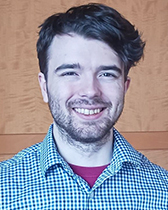Student Spotlight: Andrew Salij
 Andrew Salij, a fifth-year graduate student in the Tempelaar Group, is a computational physical chemist. His work includes building tools in Python in order to understand the optical and electronic properties of materials of the future. Andrew received the Outstanding Researcher Visionary Award at the 2023 IIN Annual Symposium for his work on 2D chiral polaritons.
Andrew Salij, a fifth-year graduate student in the Tempelaar Group, is a computational physical chemist. His work includes building tools in Python in order to understand the optical and electronic properties of materials of the future. Andrew received the Outstanding Researcher Visionary Award at the 2023 IIN Annual Symposium for his work on 2D chiral polaritons.
What made you decide to attend Northwestern University?
I had the pleasure of getting to know Northwestern’s campus while working with the Center for Talent Development over several summers prior to joining the Chemistry department. In part due to this experience, I was already quite familiar with much of the excellent research that was being done in theoretical and physical chemistry, my areas of focus. Culture-wise, I was also very attracted to the inquisitive attitudes and rigorous natures of the students and faculty with whom I interacted while choosing where to attend.
How did you become interested in your area of chemistry research?
I work in theoretical physical chemistry, which means that I use mathematics to help us gain a greater insight into the physical processes in which matter participates. Here, one acts as an intermediary between many disciplines, such as physics, materials science, chemistry proper, and even computer science. I really appreciate not only always having new subjects and skills to learn and connections to make but also being able to communicate and collaborate with a number of excellent scientists from many backgrounds, both here at Northwestern and beyond.
How would you explain what you study to non-scientists?
Let’s say that you were in a house of mirrors, but somebody suddenly turned off all of the lights. The light would keep bouncing around for a while before ultimately running out, as no mirrors are perfect. What I study is taking that kind of a mirror setup with repeated reflections down to the nanoscale, where quantum mechanics becomes impossible to ignore. On the chemistry side, I’m interested in taking crystals that behave as their mirror opposites when flipped and putting them between mirrors such that the mirror effects cancel out (like how -1*-1 = 1). This kind of situation means that any light coming in will “see” the crystal many times and thus create a much stronger effect than otherwise. One of the central properties that I study is that of light polarization, which is the manner in which light waves wobble as they propagate through space. Just like how putting on polarized sunglasses can produce the desirable effect of reducing glare, controlling polarization at the nanoscale lets us control photonic information and create electromagnetic environments with special properties.
Tell us more about the research you are conducting with the Tempelaar Team?
Specifically, I test a number of hypotheses in quantum chemistry and photonics by writing software, running calculations, and even doing some pen-and-paper mathematics to ensure that I understand the physics at play at a human-readable level. There are ultimately two broad directions of my work: starting from quantum mechanical foundations and building up and beginning with aggregate desired properties, then working down to find how they can be engineered. From both perspectives, we arrive at the nanoscale, which is small enough to unlock the possibilities of quantum mechanics and large enough to have ample design space. Ultimately, I work to draw a mathematical throughline from quantum mechanics to observed spectroscopic signals, which present a great deal of information despite looking like squiggles to the naked eye.
What has been the highlight of your academic career thus far?
While the stereotype of a scientist may be of an isolated person in their laboratory or office pondering nature’s mysteries, the reality entails a great deal of collaboration and communication. Last year, for example, I had the pleasure of meeting with my colleagues across the Atlantic at the International Symposium on Chirality in Rome. This was a great time to directly teach and learn from a number of excellent scientists, foster collegial relationships, and eat a good deal of pizza that makes for a strong contender to that from Chicago (heresy, I know!).
Where do you hope to be in your career in the next 10 years?
Now is an exhilarating time to be a computational scientist, both with more powerful computers enabling previously impossible-to-solve challenges to be addressed and with advances in domains such as machine learning adding to the suite of tools at our disposal. I’m sure I’ll be surprised by what I’ll be working on a decade from now, but in any case, I hope to be able to pay forward the excellent mentorship I’ve experienced here at Northwestern. At present, I find myself most drawn to the scale and scope of industrial challenges, so that's where I've been directing the majority of my potential career trajectories.
What is a hobby or activity you do outside of your work in chemistry?
For the last decade, I’ve been involved in the team academic sport known as “quiz bowl” and have had the pleasure of representing Northwestern during my time here. It’s a great way to learn new things and interface with many intellectually curious people. This will likely surprise people in the Chemistry Department, but the premier open quiz bowl tournament happens every summer right here in Tech, close to peoples’ labs. In another chemistry coincidence, a recent member of the Hupp group, Mark Taylor, has continued his teaching journey from the Northwestern lecture halls to Walter Payton in mentoring the team there and was recently recognized as an Illinois “Coach of the Year.”
